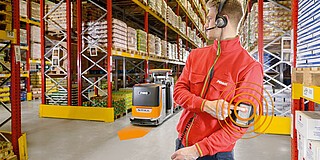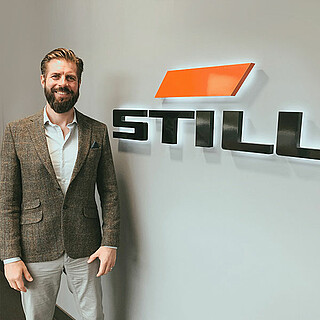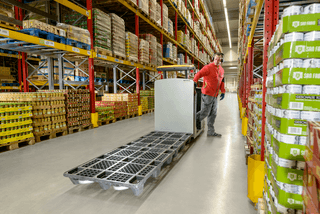What is meant by intralogistics? How STILL is helping transform supply chains

While logistics has historically meant the transfer of goods or items from point A to point B, the increasingly complex network of product and distribution has developed into a much more expanded concept; that of intralogistics. This theory of interconnected systems, real-time data and the optimisation of operators, equipment and systems has fast become essential for today’s modern logistics industries. STILL’s Managing Director, Torsten Wiecker, talks about how the company is helping transform intralogistics supply chains.
How would you define, and how does STILL’s offer support, intralogistics?
There are different perspectives to consider when we talk about intralogistics. Primarily though, it’s about optimising, integration, automation and managing the logistic flow of information and material goods. It's nothing today without information, so that is quite important within the production or distribution process.
There’s also the question of what we can provide as company to enhance intralogistics. STILL has a 100-year history within the industry. In more recent years, the additional focus is towards information and how it can be used to optimise processes. We have products to manage the information flow and make it transparent to provide the right solutions like the STILL FleetManager. We have our sustainable and powerful trucks, so we have the right hardware to handle the logistic flow within a distribution and production processes. Of course, we have our products for intralogistics solutions, which are automated systems to optimise the logistic flow. And then there’s always an operation. Equipment service and maintenance is key because logistics is always a work in progress. It's a working environment trucks must be repaired and maintained to keep operations running.
For different companies, intralogistics has different applications and there are different solutions required to meet their needs. But we are always focused on the entire package of these four pillars; solution competence, trucks, information systems and equipment servicing. We have to understand what it is the customer needs, what is their application of the customer, and find the right solution for them. At the end of the day, we want to bring a benefit to their business or to their customers. That is the most important point for us.
What role does intralogistics play in 24/7 operations?
Depending on the customer needs, warehouses can be a 24/7 operation. In some warehouse there's only one shift and they are closing on the Friday, but when you're talking to other customers or large distribution centres, they offer their goods 24/7. In those cases, you need reliable products because normally there are no engineers waiting for a service action. You also need a good and reliable support service because faults can happen with machines, but these faults can become costly if 24/7 operations need to be halted until the machinery is back up and running. It’s about managing the information, having reliable trucks with fast service options, and having the ability to cover peaks with additional short-term rental trucks. That’s a lot of information to consider, which is why you need your individual systems talking to each other and that data available so it can be easily referenced and interpreted.
With modern-day intralogistics, we are talking about a flow of information and material goods. Depending on the customer need that can be a 24/7 task and that means the need for reliable products and software solutions, combined with a professional and fast service. For STILL, our NPS above 60 speaks for itself.
How does STILL’s offering help warehouse planning, both for start-up and established warehouses?
STILL can look back on almost 100 years of history, knowledge and experience that’s been gathered over the decades. For an existing warehouse, we would look to understand how it operates today. What is the process? What are the problems? What is the purpose of business? What is the aim of the customer? It is important to have that transparency and to understand what the business needs, and then to think about the right solution for them. We don’t operate on a “one-size-fits-all” basis. We pride ourselves on a solution-orientated approach for each customer and we can call upon the vast amount of knowledge within our company thanks to the competency and experience we have within our team. Finally, it's about individuality; to understand the warehouse’s needs and future plans which may need to be considered.

What role does racking play in intralogistics and supply chain transformation?
Racking can be a part of an intralogistics solution. You can condense how you store your goods in a warehouse and having a good racking system can heavily increase the amount of space you have available. A good racking system is most effective when it is combined with the right trucks. If you combine space and vehicle optimisation with good data management you can heavily increase the performance and efficiency of a warehouse. Good racking solutions can solve problems for the customer.
What role does automation play in intralogistics and how does STILL’s offer benefit supply chains?
The challenges today are different for different customers. One challenge could be to manage capacity of that stock because warehouses have a finite amount of space. You can optimize your warehouse space with racking and potentially add additional aisles because you’re racking in a more intelligent way, and automated solutions can help manage this stock levels vs availability balance.
Another key challenge faced by businesses that automation can help solve the point that It can sometimes be difficult in countries and regions or at certain times of year to recruit enough qualified operators to drive trucks. In 24/7 operations especially, there's an high physical stress for the operators which can be reduced by automated solutions. Failures can happen in every manual process due to human error so if you need to reduce the number of errors occurring in a warehouse, an automated solution can help. The automated processes or automated trucks can reduce these errors and even semi-automated solutions can reduce accidents by removing human error and taking some of the strain off the operator. As an example, we have a customer who is running a new warehouse and decided to implement an automated solution. With this solution in place, they’ve had no damages reported. The operation was 24/7, meaning that it was a little slower than at their older site, but by running 24/7 the output was much higher so overall their efficiency was increased.
Automated solutions come in at different levels. On one side, you have assisted systems, just like you have in modern cars to assist the driver (driver assist parking, automatic breaking systems etc). Similar to this is our product called the iGo pilot. And then we have a semi-automated driving solution called the iGo neo, which is a truck that can follow the operator as they pick orders but can also be operated manually as well. Then there is the fully automated range of trucks where no driver operator is needed. This covers our iGo systems product range. So, we have different levels of products available depending on the situation. Our approach is to understand what the customer needs, collect and analyse data in order to optimise the current process and then provide the right intralogistics solution for them.
What do you see for the future for intralogistics?
Intralogistics from my perspective is primarily about four things; solutions, trucks, systems and service. I see these things becoming much more integrated in the future. All the systems already talk to each other, but new technologies like 5G make data-sharing much faster and easier. This, combined with user-friendly apps and platform, will make the transfer of vast amounts of data and real-time information easier than ever. It’s much easier to link your phone to your car than it was five years ago so we can already see these connections in our day to day lives. From my perspective, that will be one of the biggest trends in the future.
The other element of intralogistics that is becoming increasingly important is sustainability. We’re already having those discussions in society about our carbon footprint. We see a clear trend in the market to electric trucks. It’s not only about reducing our carbon footprint, but when we talk about intralogistics and warehouse operations in the future we will talk about sustainability. Sustainability will be much more important and finding good solutions for the new generation of vehicles and making things easier to repair rather than replace at environmental cost.

Comments
No comments
Subscribe to our blog!
As soon as a new article is published, we will notify you! You can unsubscribe at anytime.

Leave a comment